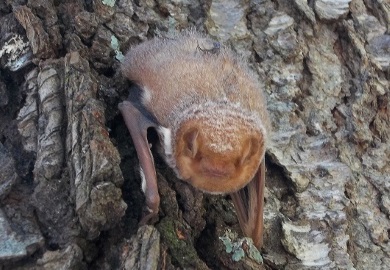DNR News** Archived Article - please check for current information. **
What to do when a bat is inside your home October 26, 2018

An Eastern Red Bat holds onto tree. (Credit: SCDNR photo by Mary Bunch)
With Halloween less than a week away, many people decorate their homes with spider webs, skeletons and bats. Plastic bats serve as great decorations, but what should you do if you find yourself with a live bat inside your home?
South Carolina is home to 14 different species of bat, but only half are colonial cavity roosting species. Those species form large groups and sometimes use human dwellings. Of those species, most cases of unwanted bats in man-made structures are attributed to four common species: the free-tailed bat (Tadarida brasiliensis), big brown bat (Eptesicus fuscus), evening bat (Nycticeius humeralis) and sometimes the tri-colored bat (Perimyotis subflavus). The latter species is becoming increasingly rare due to rapidly declining populations caused by White-nose Syndrome.
All the stateís bats feed on insects and are nocturnal. Theyíre able to navigate and locate prey using sound waves through the large gap between their front teeth. This allows them to emit high-pitched sounds out of their mouths at about 10-20 beeps per second. This gap also makes it impossible for bats to create holes in structures - only getting inside through preexisting crevices, gaps or holes.
If you find a bat in your home, itís important that you donít swat at it while itís flying. If it lands within reach, put on thick gloves and cover it with a towel. If the bat is on a curtain or wall, place a small box over the bat, then slide a piece of cardboard over the opening to trap the bat.
If you think you have been exposed to a bat, call SCDHEC immediately. Do not release the bat unless they direct you to do so. According to the SCDHEC website, even if you havenít been bitten by a bat, you are considered exposed to a bat if you:
- Waking up to find a bat in your room;
- Finding a bat where children, pets, or persons with impaired mental capacity (intoxicated or mentally disabled) have been left unattended;
- A pet or person that has been in direct contact with a bat.
If no one has been exposed, the bat can be released outside on a tree or other high object. Do not leave the bat in a container for release because it will have trouble crawling out. Once the bat is outside your home, try to find out where it got in and make sure there are no other animals, like raccoons or squirrels, inside either.
Though bats can carry rabies just like any other mammal, they are an integral part of our ecosystem and economy. Less than one percent of natural bat populations were found to carry the rabies virus, according to a Canadian study.
Bats eat mosquitoes, forest and crop pests, and save the South Carolina agricultural industry an average of $115 million every year. They are also fascinating: the Brazilian free-tailed bat is the fastest flying animal on the planet at 100 mph.
If youíre not comfortable removing the bat from your home, you can hire a Wildlife Control Operator to remove the bat.
DNR Media Contacts
| Area | Personnel | Number |
|---|---|---|
| Coastal | David Lucas | 843-610-0096 |
| Marine | Erin Weeks | 843-953-9845 |
| Midlands | Kaley Nevin | 803-917-0398 |
| Upstate | Greg Lucas | 864-380-5201 |
After Hours Radio Room - 803-955-4000
